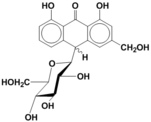
|

|
| Compound | Barbaloin |
| Animal species | human intestinal microflora, human intestinal bacteria Eubacterium sp. BAR |
| Metabolism parameters | |
| Metabolites |
Barbaloin
Aloe-emodin anthrone |
| Crude drug | Aloe |
| References | 1) Hattori M., Kanda T., Shu Y. Z., Akao T., Kobashi K. and Namba T.: Metabolism of barbaloin by intestinal bacteria. Chem. Pharm. Bull., 36, 4462-4466 (1988). 2) Che Q. M., Akao T., Hattori M., Kobashi K. and Namba T.: Isolation of a human intestinal bacterium capable of transforming barbaloin to aloe-emodin anthrone. Planta Med., 57, 15-19 (1991). 3) Che Q. M., Akao T., Hattori M., Tsuda Y., Namba T. and Kobashi K.: Barbaloin stimulates growth of Eubacterium sp. strain BAR, a barbaloin-metabolizing bacterium from human feces. Chem. Pharm. Bull., 39, 757-760 (1991). 5) Hattori M., Akao T., Kobashi K. and Namba T.: Cleavages of the O- and C-glucosyl bonds anthrone10, 10′-bi-anthrone derivatives by human intestinal bacteria. Pharmacology, 47 (suppl 1), 125-133 (1993). 6) Akao T., Che Q. M., Kobashi K., Hattori M. and Namba T.: A purgative action of barbaloin is induced by Eubacterium sp. strain BAR, a human intestinal anaerobe, capable of transforming barbaloin to aloe-emodin anthrone. Biol. Pharm. Bull., 19, 136-138 (1996). |
| Remarks |

